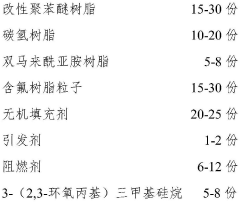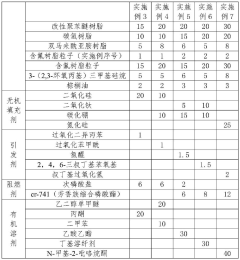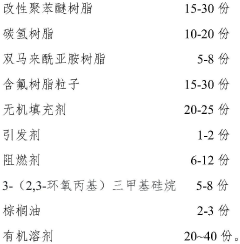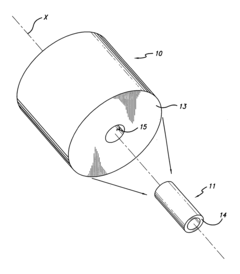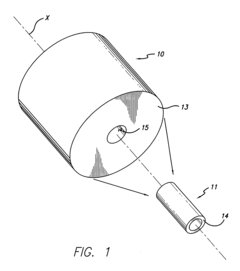PTFE: Transforming the Future of Material Science
JUN 27, 20258 MIN READ
Generate Your Research Report Instantly with AI Agent
Patsnap Eureka helps you evaluate technical feasibility & market potential.
PTFE Evolution and Objectives
Polytetrafluoroethylene (PTFE), commonly known as Teflon, has revolutionized material science since its accidental discovery in 1938 by Roy Plunkett at DuPont. This synthetic fluoropolymer has evolved from a niche material to a ubiquitous presence in various industries due to its exceptional properties, including high heat resistance, chemical inertness, and low friction coefficient.
The evolution of PTFE technology has been marked by continuous improvements in synthesis methods, processing techniques, and application development. Initially limited by its high molecular weight and difficulty in processing, researchers have made significant strides in overcoming these challenges. The development of modified PTFE grades and PTFE composites has expanded its utility across diverse sectors, from cookware to aerospace.
In recent years, the focus has shifted towards enhancing PTFE's sustainability profile and exploring its potential in emerging technologies. Efforts are being made to develop eco-friendly production methods, improve recycling processes, and reduce the environmental impact of PTFE throughout its lifecycle. Additionally, researchers are investigating PTFE's applications in advanced fields such as nanotechnology, biomedical engineering, and energy storage systems.
The primary objectives in PTFE research and development are multifaceted. Scientists aim to further improve the material's already impressive properties, such as increasing its temperature resistance beyond the current limits and enhancing its mechanical strength without compromising its unique characteristics. There is also a growing emphasis on developing PTFE variants with improved processability, which could open up new manufacturing possibilities and applications.
Another key objective is to explore PTFE's potential in addressing global challenges. This includes investigating its role in water purification technologies, energy-efficient coatings for buildings and vehicles, and advanced medical devices. Researchers are also focusing on integrating PTFE with other materials to create novel composites with synergistic properties, potentially leading to breakthroughs in various technological domains.
As we look to the future, the evolution of PTFE is expected to continue, driven by advancements in material science, nanotechnology, and sustainable manufacturing practices. The objectives for PTFE development are aligned with broader societal goals, such as reducing environmental impact, improving energy efficiency, and enhancing human health and safety. By addressing these challenges, PTFE is poised to maintain its position as a transformative material in science and industry for decades to come.
The evolution of PTFE technology has been marked by continuous improvements in synthesis methods, processing techniques, and application development. Initially limited by its high molecular weight and difficulty in processing, researchers have made significant strides in overcoming these challenges. The development of modified PTFE grades and PTFE composites has expanded its utility across diverse sectors, from cookware to aerospace.
In recent years, the focus has shifted towards enhancing PTFE's sustainability profile and exploring its potential in emerging technologies. Efforts are being made to develop eco-friendly production methods, improve recycling processes, and reduce the environmental impact of PTFE throughout its lifecycle. Additionally, researchers are investigating PTFE's applications in advanced fields such as nanotechnology, biomedical engineering, and energy storage systems.
The primary objectives in PTFE research and development are multifaceted. Scientists aim to further improve the material's already impressive properties, such as increasing its temperature resistance beyond the current limits and enhancing its mechanical strength without compromising its unique characteristics. There is also a growing emphasis on developing PTFE variants with improved processability, which could open up new manufacturing possibilities and applications.
Another key objective is to explore PTFE's potential in addressing global challenges. This includes investigating its role in water purification technologies, energy-efficient coatings for buildings and vehicles, and advanced medical devices. Researchers are also focusing on integrating PTFE with other materials to create novel composites with synergistic properties, potentially leading to breakthroughs in various technological domains.
As we look to the future, the evolution of PTFE is expected to continue, driven by advancements in material science, nanotechnology, and sustainable manufacturing practices. The objectives for PTFE development are aligned with broader societal goals, such as reducing environmental impact, improving energy efficiency, and enhancing human health and safety. By addressing these challenges, PTFE is poised to maintain its position as a transformative material in science and industry for decades to come.
PTFE Market Demand Analysis
The global market for Polytetrafluoroethylene (PTFE) has been experiencing steady growth, driven by its unique properties and diverse applications across various industries. PTFE's exceptional chemical resistance, low friction coefficient, and high-temperature stability make it a sought-after material in numerous sectors, including automotive, electronics, industrial manufacturing, and healthcare.
In the automotive industry, PTFE is increasingly used in gaskets, seals, and bearings due to its ability to withstand harsh environments and reduce friction. This demand is further amplified by the growing electric vehicle market, where PTFE's electrical insulation properties are highly valued. The electronics sector also shows a strong appetite for PTFE, particularly in the production of high-frequency circuit boards and cable insulation, driven by the expansion of 5G networks and the Internet of Things (IoT).
The industrial manufacturing sector remains a significant consumer of PTFE, utilizing it in chemical processing equipment, non-stick coatings, and filtration systems. The material's resistance to corrosive chemicals and high temperatures makes it indispensable in these applications. Additionally, the healthcare industry's demand for PTFE is on the rise, particularly in medical devices and implants, owing to its biocompatibility and non-reactive nature.
Emerging applications in renewable energy technologies, such as fuel cells and solar panels, are opening new avenues for PTFE market growth. The material's durability and weather resistance make it an excellent choice for these outdoor applications. Furthermore, the aerospace industry's continuous pursuit of lightweight and high-performance materials has led to increased adoption of PTFE in aircraft components and space exploration equipment.
The Asia-Pacific region, particularly China and India, is expected to be the fastest-growing market for PTFE, driven by rapid industrialization and infrastructure development. North America and Europe continue to be significant markets, with a focus on high-end applications and technological advancements in PTFE formulations.
Despite its growth, the PTFE market faces challenges related to environmental concerns and regulatory pressures. The persistence of fluoropolymers in the environment has led to increased scrutiny and calls for more sustainable alternatives. This has spurred research into bio-based and recyclable PTFE alternatives, potentially reshaping the market landscape in the coming years.
In the automotive industry, PTFE is increasingly used in gaskets, seals, and bearings due to its ability to withstand harsh environments and reduce friction. This demand is further amplified by the growing electric vehicle market, where PTFE's electrical insulation properties are highly valued. The electronics sector also shows a strong appetite for PTFE, particularly in the production of high-frequency circuit boards and cable insulation, driven by the expansion of 5G networks and the Internet of Things (IoT).
The industrial manufacturing sector remains a significant consumer of PTFE, utilizing it in chemical processing equipment, non-stick coatings, and filtration systems. The material's resistance to corrosive chemicals and high temperatures makes it indispensable in these applications. Additionally, the healthcare industry's demand for PTFE is on the rise, particularly in medical devices and implants, owing to its biocompatibility and non-reactive nature.
Emerging applications in renewable energy technologies, such as fuel cells and solar panels, are opening new avenues for PTFE market growth. The material's durability and weather resistance make it an excellent choice for these outdoor applications. Furthermore, the aerospace industry's continuous pursuit of lightweight and high-performance materials has led to increased adoption of PTFE in aircraft components and space exploration equipment.
The Asia-Pacific region, particularly China and India, is expected to be the fastest-growing market for PTFE, driven by rapid industrialization and infrastructure development. North America and Europe continue to be significant markets, with a focus on high-end applications and technological advancements in PTFE formulations.
Despite its growth, the PTFE market faces challenges related to environmental concerns and regulatory pressures. The persistence of fluoropolymers in the environment has led to increased scrutiny and calls for more sustainable alternatives. This has spurred research into bio-based and recyclable PTFE alternatives, potentially reshaping the market landscape in the coming years.
PTFE Technical Challenges
Despite its remarkable properties, PTFE faces several technical challenges that hinder its wider application and limit its potential in various industries. One of the primary challenges is the difficulty in processing PTFE due to its high melting point and viscosity. Traditional manufacturing methods often struggle to produce complex shapes or thin films of PTFE without compromising its unique properties.
Another significant challenge lies in the adhesion of PTFE to other materials. The very property that makes PTFE non-stick – its low surface energy – also makes it challenging to bond with other substances. This limitation restricts its use in composite materials and multi-layer applications, where strong adhesion is crucial for structural integrity and performance.
The recyclability of PTFE presents another technical hurdle. Unlike many other plastics, PTFE cannot be easily melted and reformed, making it difficult to recycle through conventional methods. This not only raises environmental concerns but also increases the overall cost of PTFE products due to limited end-of-life options.
PTFE's thermal stability, while generally an advantage, can become a challenge in extreme high-temperature applications. At temperatures above 260°C, PTFE begins to degrade, releasing potentially harmful fluorine-containing compounds. This thermal limitation restricts its use in certain high-temperature industrial processes and aerospace applications.
The modification of PTFE's surface properties without altering its bulk characteristics remains a complex task. Researchers and engineers are continually seeking ways to enhance PTFE's wettability, printability, and compatibility with other materials while maintaining its core benefits. This balancing act between surface modification and bulk property preservation represents a significant technical challenge.
In the realm of electrical applications, PTFE's excellent insulating properties can sometimes be a double-edged sword. While beneficial in many scenarios, this high electrical resistance can lead to static charge accumulation, which is problematic in certain electronic and manufacturing environments where electrostatic discharge is a concern.
Lastly, the cost-effective production of PTFE, especially for high-purity grades required in sensitive applications like semiconductor manufacturing, remains a challenge. The complex synthesis process and the need for specialized equipment contribute to the relatively high cost of PTFE, limiting its adoption in price-sensitive markets.
Another significant challenge lies in the adhesion of PTFE to other materials. The very property that makes PTFE non-stick – its low surface energy – also makes it challenging to bond with other substances. This limitation restricts its use in composite materials and multi-layer applications, where strong adhesion is crucial for structural integrity and performance.
The recyclability of PTFE presents another technical hurdle. Unlike many other plastics, PTFE cannot be easily melted and reformed, making it difficult to recycle through conventional methods. This not only raises environmental concerns but also increases the overall cost of PTFE products due to limited end-of-life options.
PTFE's thermal stability, while generally an advantage, can become a challenge in extreme high-temperature applications. At temperatures above 260°C, PTFE begins to degrade, releasing potentially harmful fluorine-containing compounds. This thermal limitation restricts its use in certain high-temperature industrial processes and aerospace applications.
The modification of PTFE's surface properties without altering its bulk characteristics remains a complex task. Researchers and engineers are continually seeking ways to enhance PTFE's wettability, printability, and compatibility with other materials while maintaining its core benefits. This balancing act between surface modification and bulk property preservation represents a significant technical challenge.
In the realm of electrical applications, PTFE's excellent insulating properties can sometimes be a double-edged sword. While beneficial in many scenarios, this high electrical resistance can lead to static charge accumulation, which is problematic in certain electronic and manufacturing environments where electrostatic discharge is a concern.
Lastly, the cost-effective production of PTFE, especially for high-purity grades required in sensitive applications like semiconductor manufacturing, remains a challenge. The complex synthesis process and the need for specialized equipment contribute to the relatively high cost of PTFE, limiting its adoption in price-sensitive markets.
Current PTFE Applications
01 PTFE manufacturing processes
Various methods for producing PTFE are described, including polymerization techniques, extrusion processes, and molding methods. These processes aim to improve the quality, consistency, and properties of PTFE products for different applications.- PTFE manufacturing and processing techniques: Various methods for manufacturing and processing PTFE are described, including techniques for improving its properties and performance. These processes may involve specific temperature and pressure conditions, as well as the use of additives or fillers to enhance the material's characteristics.
- PTFE composites and blends: The development of PTFE composites and blends with other materials to enhance specific properties such as wear resistance, thermal conductivity, or mechanical strength. These composites may incorporate various fillers, nanoparticles, or other polymers to achieve desired characteristics for specific applications.
- PTFE surface modification and coating technologies: Techniques for modifying the surface properties of PTFE or using it as a coating material. This includes methods for improving adhesion, creating hydrophobic or hydrophilic surfaces, and developing specialized coatings for various industrial applications.
- PTFE in membrane and filtration applications: The use of PTFE in membrane and filtration technologies, including the development of porous PTFE structures, expanded PTFE (ePTFE) membranes, and their applications in water treatment, gas separation, and other filtration processes.
- PTFE recycling and environmental considerations: Methods for recycling PTFE materials and addressing environmental concerns related to PTFE production and disposal. This includes techniques for breaking down PTFE, recovering valuable components, and developing more sustainable manufacturing processes.
02 PTFE composite materials
PTFE is combined with other materials to create composite structures with enhanced properties. These composites may include reinforcing fibers, nanoparticles, or other polymers to improve mechanical strength, thermal stability, or electrical properties.Expand Specific Solutions03 Surface modification of PTFE
Techniques for modifying the surface of PTFE to enhance its properties or compatibility with other materials are explored. These may include chemical treatments, plasma treatments, or the application of coatings to improve adhesion or other surface characteristics.Expand Specific Solutions04 PTFE in membrane technology
The use of PTFE in membrane applications is discussed, including its role in filtration, separation, and gas diffusion processes. PTFE membranes are developed with specific pore sizes and structures for various industrial and medical applications.Expand Specific Solutions05 PTFE in electronic and electrical applications
PTFE is utilized in electronic and electrical components due to its excellent dielectric properties and thermal stability. Applications include insulation for wires and cables, printed circuit boards, and high-frequency components.Expand Specific Solutions
Key PTFE Industry Players
The PTFE (Polytetrafluoroethylene) market is in a mature stage, with established players like DAIKIN INDUSTRIES Ltd., W. L. Gore & Associates, Inc., and DuPont de Nemours, Inc. dominating the industry. The global PTFE market size is substantial, estimated to be worth several billion dollars, driven by its widespread applications in various industries. Technologically, PTFE is well-developed, but ongoing research by companies and institutions such as Zhejiang University and The Chemours Co. continues to push the boundaries of its capabilities and applications. These advancements are focusing on enhancing PTFE's properties and exploring new uses in emerging fields, indicating a shift towards more specialized and high-performance applications in material science.
DAIKIN INDUSTRIES Ltd.
Technical Solution: Daikin has made significant strides in PTFE technology, particularly in the realm of fine powder PTFE and aqueous PTFE dispersions. Their recent innovations include the development of PTFE grades with ultra-low friction coefficients, suitable for advanced bearings and seals in automotive and industrial applications[10]. Daikin has also pioneered new processing techniques for PTFE, such as their proprietary sintering method that results in PTFE products with enhanced mechanical properties and reduced porosity[11]. In the field of electronics, they have introduced PTFE-based materials with improved dielectric properties for high-frequency applications[12].
Strengths: Strong presence in Asian markets, diversified product portfolio beyond PTFE. Weaknesses: Intense competition in the PTFE market, particularly from other Japanese and Chinese manufacturers.
W. L. Gore & Associates, Inc.
Technical Solution: W. L. Gore & Associates has revolutionized PTFE applications through their proprietary ePTFE (expanded PTFE) technology. Their latest innovations include advanced ePTFE membranes with nanoscale pore structures, offering unprecedented combinations of breathability and waterproofing for high-performance textiles[4]. In the medical field, Gore has developed PTFE-based vascular grafts with improved biocompatibility and long-term patency rates[5]. They have also made strides in industrial applications, creating PTFE-based filtration solutions that can withstand extreme temperatures and chemical environments while maintaining high efficiency[6].
Strengths: Proprietary ePTFE technology, strong presence in high-value markets like medical devices and high-performance textiles. Weaknesses: Heavy reliance on PTFE-based products may pose risks if alternative materials gain traction.
PTFE Innovations Overview
Resin composition with excellent compatibility as well as preparation method and application thereof
PatentActiveCN116656111A
Innovation
- Using modified polyphenylene ether, hydrocarbon resin and bismaleimide combined with modified fluorine-containing resin particles, PTFE is modified through sodium naphthalene solution chemical treatment to increase its surface energy, and the modified PTFE particles are polymerized with The compounding of matrix polymer improves compatibility and processing performance.
Radially expandable polytetrafluoroethylene
PatentInactiveUS20040157024A1
Innovation
- The development of PTFE products with a unique processing method involving extrusion, solvent removal, stretching, and sintering, which results in a microstructure of nodes interconnected by fibrils, allowing for significant radial expansion (up to 50% to 400%) while retaining structural integrity and tensile strength, achieved through controlled lubricant levels and processing conditions.
PTFE Environmental Impact
The environmental impact of Polytetrafluoroethylene (PTFE) is a complex and multifaceted issue that requires careful consideration. PTFE, commonly known by its brand name Teflon, has been widely used in various industries due to its unique properties, including chemical resistance, low friction, and high temperature stability. However, its production and disposal have raised significant environmental concerns.
The manufacturing process of PTFE involves the use of perfluorooctanoic acid (PFOA), a persistent organic pollutant that has been linked to various health and environmental issues. PFOA can contaminate water sources and accumulate in living organisms, potentially causing long-term ecological damage. In response to these concerns, many manufacturers have committed to phasing out PFOA and developing alternative production methods.
Despite efforts to improve production processes, the disposal of PTFE products remains a significant environmental challenge. PTFE is not biodegradable and can persist in the environment for extended periods. When incinerated, it can release harmful fluorine compounds, contributing to air pollution and potentially affecting human health.
However, the durability and longevity of PTFE products also present an environmental advantage. The extended lifespan of PTFE-coated products reduces the need for frequent replacements, potentially lowering overall resource consumption and waste generation. Additionally, PTFE's non-stick properties can reduce the use of cleaning chemicals in various applications, indirectly contributing to environmental protection.
Recent research has focused on developing more environmentally friendly alternatives to traditional PTFE. These include water-based PTFE coatings and bio-based fluoropolymers that aim to maintain the beneficial properties of PTFE while reducing its environmental footprint. Recycling technologies for PTFE are also being explored, although the process remains challenging due to the material's chemical stability.
The environmental impact of PTFE extends beyond its production and disposal. Its use in various industries, such as automotive and aerospace, can contribute to improved fuel efficiency and reduced emissions. In medical applications, PTFE's biocompatibility and durability can lead to longer-lasting implants, potentially reducing the need for repeat surgeries and associated resource consumption.
As the material science field continues to evolve, balancing the unique properties of PTFE with environmental sustainability remains a key challenge. Future developments in PTFE technology will likely focus on greener production methods, improved recyclability, and the development of eco-friendly alternatives that can match or exceed PTFE's performance characteristics.
The manufacturing process of PTFE involves the use of perfluorooctanoic acid (PFOA), a persistent organic pollutant that has been linked to various health and environmental issues. PFOA can contaminate water sources and accumulate in living organisms, potentially causing long-term ecological damage. In response to these concerns, many manufacturers have committed to phasing out PFOA and developing alternative production methods.
Despite efforts to improve production processes, the disposal of PTFE products remains a significant environmental challenge. PTFE is not biodegradable and can persist in the environment for extended periods. When incinerated, it can release harmful fluorine compounds, contributing to air pollution and potentially affecting human health.
However, the durability and longevity of PTFE products also present an environmental advantage. The extended lifespan of PTFE-coated products reduces the need for frequent replacements, potentially lowering overall resource consumption and waste generation. Additionally, PTFE's non-stick properties can reduce the use of cleaning chemicals in various applications, indirectly contributing to environmental protection.
Recent research has focused on developing more environmentally friendly alternatives to traditional PTFE. These include water-based PTFE coatings and bio-based fluoropolymers that aim to maintain the beneficial properties of PTFE while reducing its environmental footprint. Recycling technologies for PTFE are also being explored, although the process remains challenging due to the material's chemical stability.
The environmental impact of PTFE extends beyond its production and disposal. Its use in various industries, such as automotive and aerospace, can contribute to improved fuel efficiency and reduced emissions. In medical applications, PTFE's biocompatibility and durability can lead to longer-lasting implants, potentially reducing the need for repeat surgeries and associated resource consumption.
As the material science field continues to evolve, balancing the unique properties of PTFE with environmental sustainability remains a key challenge. Future developments in PTFE technology will likely focus on greener production methods, improved recyclability, and the development of eco-friendly alternatives that can match or exceed PTFE's performance characteristics.
PTFE Regulatory Framework
The regulatory framework surrounding PTFE (Polytetrafluoroethylene) plays a crucial role in shaping its development, production, and application across various industries. As a material with unique properties and widespread use, PTFE is subject to a complex web of regulations that aim to ensure safety, environmental protection, and quality standards.
In the United States, the Environmental Protection Agency (EPA) regulates PTFE under the Toxic Substances Control Act (TSCA). The EPA has established specific guidelines for the manufacture, processing, and distribution of PTFE, focusing on potential environmental impacts and human health risks. Additionally, the Food and Drug Administration (FDA) oversees the use of PTFE in food contact applications, medical devices, and pharmaceutical packaging, ensuring compliance with strict safety standards.
The European Union has implemented the Registration, Evaluation, Authorization, and Restriction of Chemicals (REACH) regulation, which applies to PTFE and its precursors. REACH requires manufacturers and importers to register substances and provide detailed information on their properties, hazards, and safe use. The European Food Safety Authority (EFSA) also evaluates the safety of PTFE in food contact materials, setting specific migration limits and usage conditions.
In Asia, countries like China and Japan have their own regulatory frameworks for PTFE. China's Ministry of Ecology and Environment oversees the environmental aspects of PTFE production, while the National Medical Products Administration regulates its use in medical applications. Japan's Ministry of Health, Labour and Welfare has established guidelines for PTFE in food contact materials and medical devices.
Global initiatives, such as the Stockholm Convention on Persistent Organic Pollutants, have implications for PTFE production, particularly concerning the use of perfluorooctanoic acid (PFOA) in its manufacturing process. This has led to the development of PFOA-free PTFE production methods to comply with international regulations.
The regulatory landscape for PTFE is continually evolving, with increasing focus on sustainability and circular economy principles. Recent trends include stricter controls on per- and polyfluoroalkyl substances (PFAS), which encompass certain PTFE precursors. This has prompted industry players to invest in research and development of more environmentally friendly alternatives and production processes.
As PTFE continues to transform the future of material science, navigating this complex regulatory framework remains a critical challenge for manufacturers, researchers, and end-users. Compliance with these regulations not only ensures legal and ethical operations but also drives innovation in safer and more sustainable PTFE technologies.
In the United States, the Environmental Protection Agency (EPA) regulates PTFE under the Toxic Substances Control Act (TSCA). The EPA has established specific guidelines for the manufacture, processing, and distribution of PTFE, focusing on potential environmental impacts and human health risks. Additionally, the Food and Drug Administration (FDA) oversees the use of PTFE in food contact applications, medical devices, and pharmaceutical packaging, ensuring compliance with strict safety standards.
The European Union has implemented the Registration, Evaluation, Authorization, and Restriction of Chemicals (REACH) regulation, which applies to PTFE and its precursors. REACH requires manufacturers and importers to register substances and provide detailed information on their properties, hazards, and safe use. The European Food Safety Authority (EFSA) also evaluates the safety of PTFE in food contact materials, setting specific migration limits and usage conditions.
In Asia, countries like China and Japan have their own regulatory frameworks for PTFE. China's Ministry of Ecology and Environment oversees the environmental aspects of PTFE production, while the National Medical Products Administration regulates its use in medical applications. Japan's Ministry of Health, Labour and Welfare has established guidelines for PTFE in food contact materials and medical devices.
Global initiatives, such as the Stockholm Convention on Persistent Organic Pollutants, have implications for PTFE production, particularly concerning the use of perfluorooctanoic acid (PFOA) in its manufacturing process. This has led to the development of PFOA-free PTFE production methods to comply with international regulations.
The regulatory landscape for PTFE is continually evolving, with increasing focus on sustainability and circular economy principles. Recent trends include stricter controls on per- and polyfluoroalkyl substances (PFAS), which encompass certain PTFE precursors. This has prompted industry players to invest in research and development of more environmentally friendly alternatives and production processes.
As PTFE continues to transform the future of material science, navigating this complex regulatory framework remains a critical challenge for manufacturers, researchers, and end-users. Compliance with these regulations not only ensures legal and ethical operations but also drives innovation in safer and more sustainable PTFE technologies.
Unlock deeper insights with Patsnap Eureka Quick Research — get a full tech report to explore trends and direct your research. Try now!
Generate Your Research Report Instantly with AI Agent
Supercharge your innovation with Patsnap Eureka AI Agent Platform!
